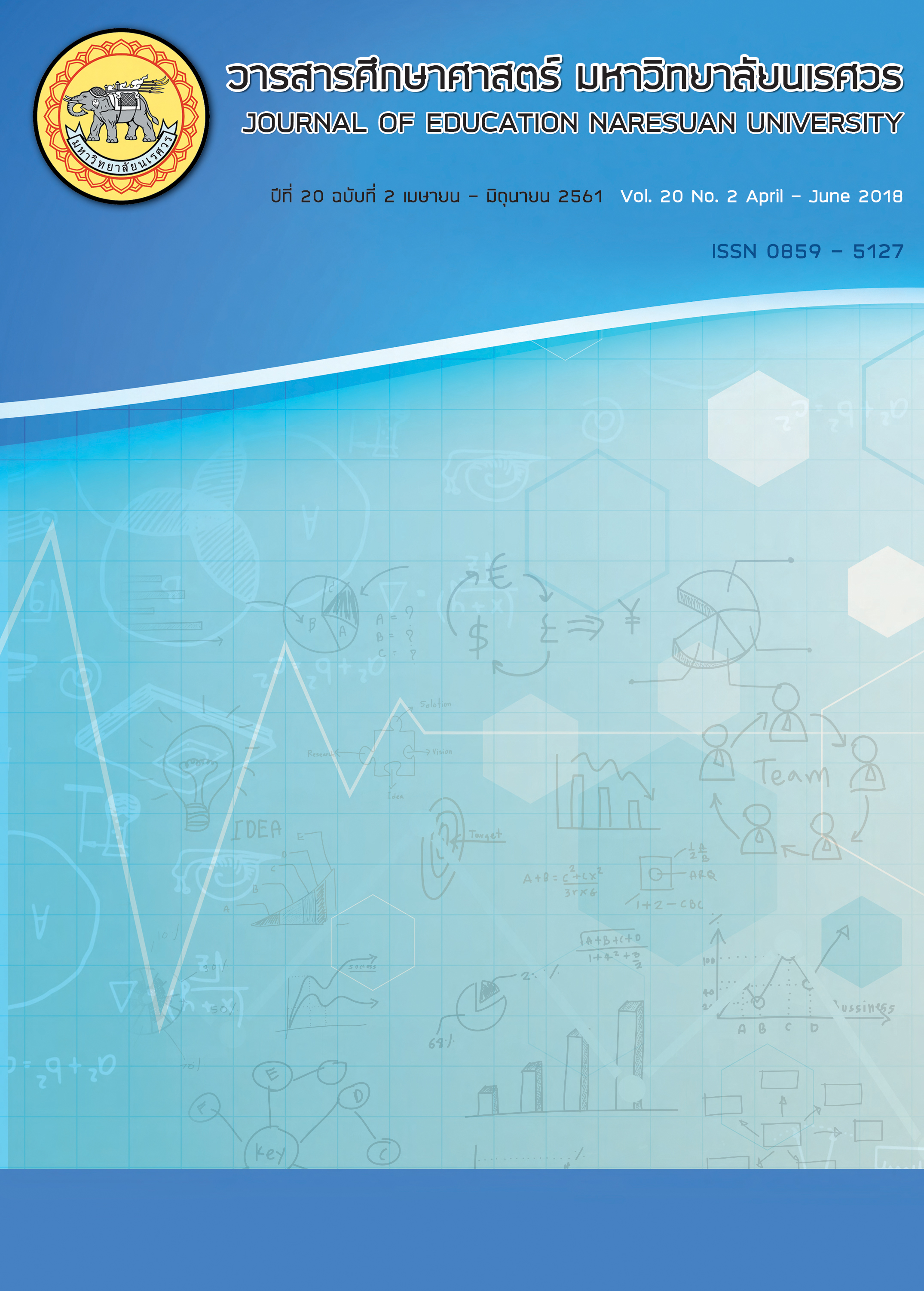ผลการจัดการเรียนรู้ตามแนวคิดวิทยาศาสตร์ เทคโนโลยีและสังคมที่มีต่อจิตสาธารณะและผลสัมฤทธิ์ทางการเรียนวิชาวิทยาศาสตร์ ของนักเรียนชั้นประถมศึกษาปีที่ 6; EFFECTS OF LEARNING MANAGEMENT BASED ON SCIENCE TECHNOLOGY AND SOCIETY APPROACH ON PUBLIC CONSCIOUSNESS...
Main Article Content
Abstract
การวิจัยครั้งนี้มีวัตถุประสงค์เพื่อศึกษาจิตสาธารณะของนักเรียนชั้นประถมศึกษาปีที่ 6 ที่ได้รับการจัดการเรียนรู้ตามแนวคิดวิทยาศาสตร์ เทคโนโลยีและสังคม และศึกษาผลสัมฤทธิ์ทางการเรียนวิทยาศาสตร์ เรื่อง สิ่งมีชีวิตกับสิ่งแวดล้อม ของนักเรียนชั้นประถมศึกษาปีที่ 6 ที่ได้รับการจัดการเรียนรู้ตามแนวคิดวิทยาศาสตร์ เทคโนโลยีและสังคม ประชากรที่ใช้ในการวิจัย เป็นนักเรียนชั้นประถมศึกษาปีที่ 6 ภาคเรียนที่ 2 ปีการศึกษา 2558 โรงเรียนวัดช่างเคี่ยน จังหวัดเชียงใหม่ จำนวน 30 คน เครื่องมือที่ใช้ในการวิจัย ประกอบด้วย แผนการจัดการเรียนรู้ตามแนวคิดวิทยาศาสตร์ เทคโนโลยีและสังคม วิชาวิทยาศาสตร์ เรื่อง สิ่งมีชีวิตกับสิ่งแวดล้อม แบบวัดจิตสาธารณะ มีค่าความเชื่อมั่นเท่ากับ 0.89 และแบบวัดผลสัมฤทธิ์ทางการเรียนวิทยาศาสตร์ เรื่อง สิ่งมีชีวิตกับสิ่งแวดล้อม มีค่าความเชื่อมั่นเท่ากับ 0.81 วิเคราะห์ข้อมูลโดยการหาค่าเฉลี่ย และส่วนเบี่ยงเบนมาตรฐาน ด้วยโปรแกรมคอมพิวเตอร์สำเร็จรูป การวิจัยปรากฏผล ดังนี้
1. นักเรียนที่ได้รับการจัดการเรียนรู้ตามแนวคิดวิทยาศาสตร์ เทคโนโลยีและสังคม ในวิชาวิทยาศาสตร์ มีค่าเฉลี่ยของระดับขั้นการมีจิตสาธารณะหลังการสอนเท่ากับ 2.12 ซึ่งอยู่ในระดับการตอบสนองสูงกว่าค่าเฉลี่ยของระดับขั้นการมีจิตสาธารณะก่อนการสอน มีค่าเท่ากับ 1.34 ซึ่ง อยู่ใน ระดับการรับรู้
2. นักเรียนที่ได้รับการจัดการเรียนรู้ตามแนวคิดวิทยาศาสตร์ เทคโนโลยีและสังคม ในวิชาวิทยาศาสตร์ เรื่อง สิ่งมีชีวิตกับสิ่งแวดล้อม มีค่าเฉลี่ยคะแนนผลสัมฤทธิ์ทางการเรียนหลังการสอน เท่ากับ 25.77 สูงกว่าค่าเฉลี่ยคะแนนผลสัมฤทธิ์ทางการเรียนก่อนการสอน ซึ่งมีค่าเท่ากับ 13.20
EFFECTS OF LEARNING MANAGEMENT BASED ON SCIENCE TECHNOLOGY AND SOCIETY APPROACH ON PUBLIC CONSCIOUSNESS AND SCIENCE LEARNING ACHIEVEMENT OF PRATHOMSUKSA 6 STUDENT
The purposes of this research were to study public consciousness and science learning achievement on “Living Things and The Environment” of Prathomsuksa 6 students taught through Science Technology and Society Approach. The population was 30 Prathomsuksa 6 students in the second semester of the academic year 2015 at Watchangkian School, Chiang Mai Province. The instruments consisted of lesson plans on “Living Things and the Environment” emphasizing on Science Technology and Society (STS) approach, public consciousness test with the reliability of 0.89 and science learning achievement test on “Living Things and The Environment” with the reliability of 0.81 Statistics used in data analysis included mean and standard deviation by using computer program Research findings were as follows:
1. Public consciousness of the students who were learning through science technology and society approach was at the response level (=2.12), and was higher than those of before learning which was at the perception level (
= 1.34).
2. The students’ mean of science learning achievement score after using science technology and society approach on “Living Things and the Environment” was 25.77 which was higher than that before learning of 13.20.
Article Details
The owner of the article does not copy or violate any of its copyright. If any copyright infringement occurs or prosecution, in any case, the Editorial Board is not involved in all the rights to the owner of the article to be performed.
References
Carin, A. A. (1997). Teaching modern science (7th ed.). New Jersey: Pretice-Hall.
Krannasoot, P. (1999). Principles of statistics (3rd ed.). Bangkok: Chulalongkorn University Press. (in Thai)
Krathwohl, David R., et al. (1964). Taxonomy of educational objectives. Handbook II affective domain. New York: David Mckay.
Mackinnu. (1992). Comparison of learning outcomes between classes taught with a science-technology-society (STS) approach and text book oriented approach. Dissertation Abstracts International, 52(7), 248 – 290.
Malai, N. (2011). Public mind and science learning achievement on living things and environment of Prathom Suksa 6 students through supplementary public mind developing activities (Master thesis). Chiang Mai: Chiang Mai University. (in Thai)
Merryfild, M. (1991). Science - technology - society and global perspectives. Theory into Practice, 30(4), 288.
Pedretti, E., & Forbes. (2000). From curriculum rhetoric to classroom reality, STSE Education Orbit, 31(3), 39-41.
Sutthirat, C. (2009). Public mind teaching. Bangkok: V Print (1991). (in Thai)
Tsai Chin-Chang. (1999). The progression to word constructivist epistemological views of science: A case study of the STS instruction of Taiwanese high school female students. International Journal of Science Education, 21(11), 120-122.


